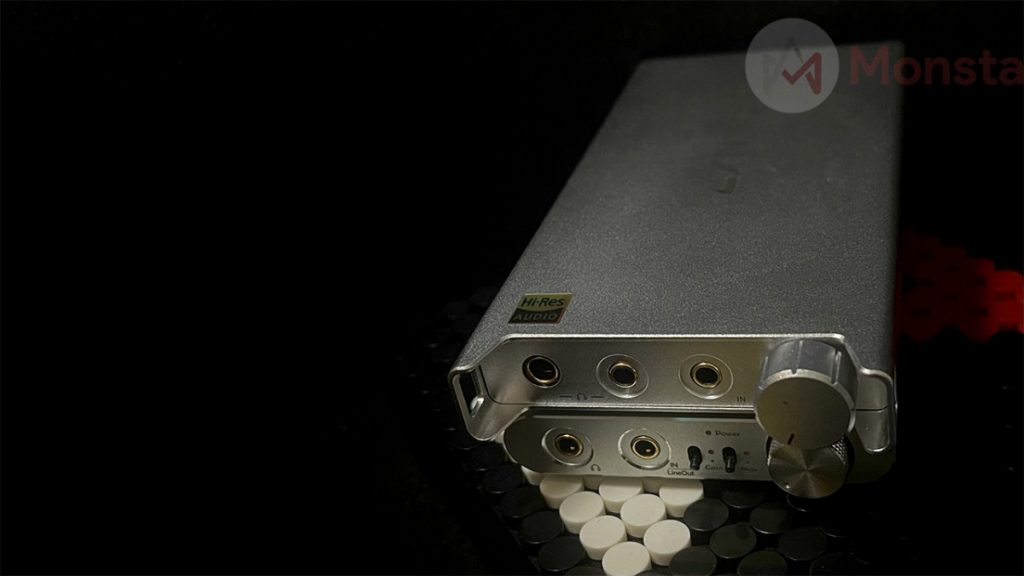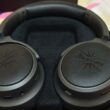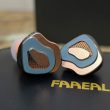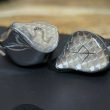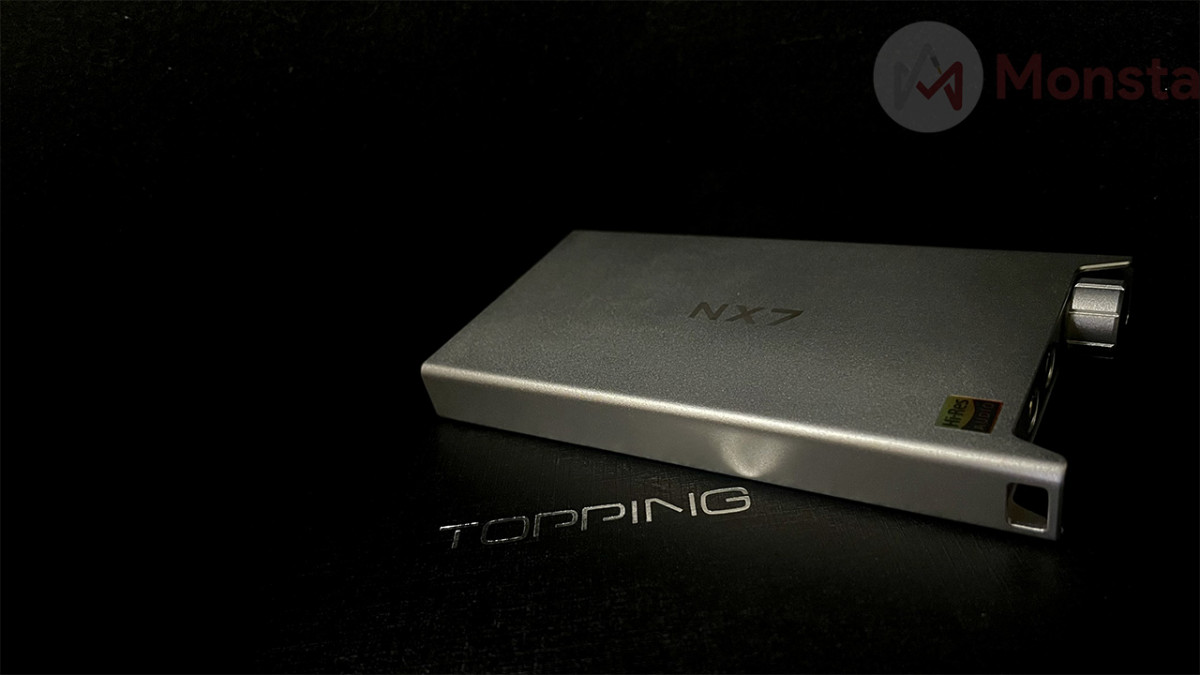Introduction
If you’re an “audiophile” and you don’t already know Topping, you really should do some homework. Being one of the leading company from the east (available globally, at least) that churns out recently class-leading (arguable, of course) desktop DACs and Amplifiers have now returned to their roots by revisiting their portable offerings. It has been a while since they launched new portable products let alone releasing any update to their currently ageing line-up and it’s about time they do some house cleaning. Starting the portable amplifier line up with the NX1s, going through to the once powerful and beloved NX3s and then to the somewhat redundant NX5, now comes the NX7. This time, Topping seems to be hitting two birds with one stone this time by addressing one of the known issues of their previous portable amplifiers (high output impedance) and also introducing one of their top-of-the-line desktop amplifier feature by using the Nested Feedback Composite Amplifier (NFCA) module as a portable package with the NX7.
Packaging & Accessories
Simple yet effective. If you’re familiar with Topping’s portable products, it is similarly packaged if not slightly improved this time around. They’re shipped in an unassuming matte black box which is sized just enough for what’s included inside (I call it practical). At least now the NX7 is nestled in its own slotted cardboard rather than a foam cutout that can be found with their NX1s, NX3s and NX4 DSD packaging.
On to the build itself, it’s similarly well-built as all the other previous Topping products. Solid. My choice of the matte silver color is only for one specific reason – for stacking purpose (more on this later) apart from it looks better to my eyes and somewhat exclusive compared to its black counterpart. It’s got a little bit of heft with that aluminium casing and there’s not a single rattle when shaken (if it concerns you by any means). The operation of the NX7 is quite simple. On the front panel there’s the volume knob which acts as a on/off and (obviously) as an analogue volume control. On the back panel there’s a gain switch (Low, Medium, High) and an LED indicator which indicate its battery life.
User Experience
For real time usage, I never actually drained its battery till it’s completely dead but what I can vouch here is that while stacking the NX7 on medium gain with FiiO M11 Plus in Line-Out mode (3.5mm), it took a good whole 2 full charges of the M11 Plus and the LED on the NX7 is still not blinking (which indicates low battery). So that’s fairly close enough to their claimed 20 hours of battery life in my opinion since the M11 Plus have been hitting a constant close to 10 hours play time in Line Out mode with both Bluetooth and WiFi turned on. Charging on the other hand took a good 3 hours before the red LED stopped blinking (which indicates full battery), and that’s when it’s not even at their very low battery level (blinking green LED).
The volume pot is smooth, which also acts as the on/off button. Then gain switch however is a little bit too small to be practical. Yes the click is very assuring when changing from one gain level to another but only if it was slightly bigger, it would be very practical. The gain jump (Low = -14dB, Medium = 0dB, High = +14dB) is fairly significant and it doesn’t have the ability to reset the volume after each gain switching (like some other high end DAP), so do be aware of that as it might damage your gears and much worse – your ears. But that’s totally nitpicking and my only real gripe is that I wish that the LED indicator is located in front of the unit anywhere near the volume pot and not behind the unit.
Functions & Specifications
- THD + N @ 1kHz – <0.00008% @ 200mW
- SNR @ 1kHz – <0.0010% @ 200mW
- Frequency Response – 20Hz to 40kHz
- Output Level – Low Gain = 2.6Vrms | Medium Gain = 3.8Vrms | High Gain = 7.4Vrms
- Output Power (High Gain) – 180mW @ 300ohms | 820mW @ 64ohms | 1400mW @ 32ohms
- Channel Crosstalk – 3.5mm = -91dB@1kHz | 4.4mm = -96dB@1kHz
On paper, the output power and Signal to Noise Ratio (SNR) is rated similarly for both 3.5mm & 4.4mm output. I was skeptical at first but after trying it for myself, true enough that they are similarly configured to achieve the same amount of power output and SNR (at least by volume matching each output to reach my preferred SPL) which is beneficial for those who’d like to keep their connectors single-ended. But changing from the 3.5mm to 4.4mm proves that the 4.4mm sounds slightly wider, yes wider and this is most likely due to the lower channel crosstalk at -96dB@1kHz in comparison to -91dB@1kHz on 3.5mm output. Other than that, it’s honestly nothing much, at least in my use case scenario and limited gears. This minor differences between the outputs reminds me of something like what Sony have been implemented all this while with their DAPs.
What’s In The Box
- Topping NX7
- Rubber Pad x 1
- Rubber Band x 2
- 3.5mm to 3.5mm interconnect x 1
Retail Price & Where To Get
Get Topping NX7 at Red Ape – Headphone Store for only RM759.00.
Purchase Link :
Shopee Red Ape – Headphone Store : https://invol.co/clai4bq
Sound & Tonality
The Topping NX7 have some respectable power for a portable amplifier, but being a trickled down version of their desktop amplifier the A90 with its NFCA topology also have its own caveat and that is; while being exceptionally transparent, they can also be too clean and dry. This is neither a good or a bad thing as long as you know what to pair with the NX7. It is more of an issue of synergy rather than anything, which is explained further below.
Source Used (audio chain)
Win11 > Foobar2k > multiple DACs > Topping NX7 > multiple IEMs.
Songs Used
Soundstage, Imaging & Separation
The NX7 provides listener with an expansive soundstage but this is highly dependent on the source and the paired output especially when it comes to imaging capability. For example, something as technical as the Moondrop Blessing 2 will retain its technical prowess while having that slightly perceivable “expanded” soundstage (especially depth) but something like the Final Audio E5000 will sound a bit smeared in imaging despite having a significantly larger soundstage in comparison to other “portable” amps in my arsenal (except for the Ifi Micro Black Label). All in all, whatever benefits best (namely dynamic driver or even planars) from such power output will have that perceivably large and expansive soundstage. Separation, as expected with such low channel crosstalk is admirable. Heck, for the asking price I have no complaints in this regards since it really complements the power output as a whole.
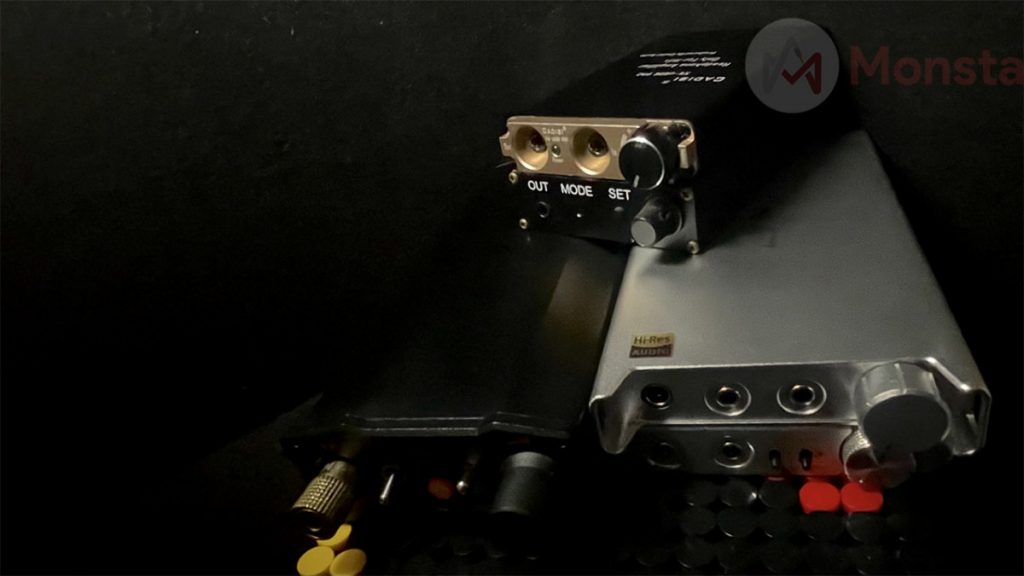
Synergy – Source
Topping NX4 DSD (Sabre ES9038Q2M)
A portable Topping stack? Why not? The NX4 is one of the reason I kept an eye on the NX7. Yes! To stack them together. Utilizing the ES9038Q2M, the NX4 is no slouch when it comes to accuracy in sound rendering and it is one of the best valued battery powered portable DAC/AMP available out there (yes, better than FiiO Q3). Only recently I have found that the NX4 benefits more by being fed from a PC/laptop (sounds fuller, more dynamics) as compared to being fed from portable sources (sounds anaemic, dull, congested). So do these two play well with each other? That depends. Because this pair is certainly not for everyone. Combining these two is like having a brain surgeon combined with a robot arm to perform a surgery. Analytical, sterile and might be too much for some.
This combo gives you a bass that is very well extended and textured. It’s never going to overpower the other frequency throughout but rather a quality bass delivery even with a warm, somewhat sloppy sounding gears. The mids can be perceived as neutral and detailed. It won’t “enhance” your IEM/headphone to suddenly be analytical in a significant manner but some nuances can clearly be heard with this combo as if it seems to be brought forward effortlessly. Treble however might be a turn-off for this particular combo. Remember how glary or metallic-ish an ESS can be? Well it’s no exception here. Cymbals are almost splashy and higher registers can be too much in some songs. Granted that all of this came from the NX4, but by boosting it further with the NX7? You do your math. As always, YMMV.
Stoner Acoustics UD130 (AKM AK4493)
Here we have a portable-sized DAC/AMP that is meant to be used on a desktop setup. The UD130 have no battery in it to be used as a fully-portable unit. It’s like a grand-daddy of all the modern sleek-looking dongles out there. Like all dongles, the UD130 at least for me is suffering in its amplifier section but then there will never be enough power for everything. For efficient IEM usage, they’re actually respectable on their own. Only when you start to plug in some ridiculously specced gears that you’ll find that it’s not enough. Heck, I’ve been using the UD130 with another amplifier (XuanZu XZ-U606) to further gain more headroom and dynamic range apart from they look nice being stacked together (size-wise).
Stacking the UD130 with the NX7 is possibly the best thing that I have experienced so far. The balance and naturality of the two units combined is heavenly (at least for my preference). Bass sounds full with visceral impact while remaining clean. It’s not as textured as the ESS nor as smooth as the Burr Brown per se but it’s in a nice in between for musicality. Being fed from the AK4493, the mids is…well…lush and grandeur-ish. There’s enough warmth that it won’t make your gear sounds sluggish yet there’s details and nuances being whispered to your ears. Treble with this particular combo is well detailed without being too fatiguing. It’s far from smooth sounding and can get pretty exciting but there’s nothing to deter you from turning up the volume even more. Engaging is what I’d like to call it. *Note that the UD130 can sound quite differently in Headphone-Out mode in comparison to Line-Out mode. It sounds slightly fuller and more neutral with the latter.
Ifi Micro iDSD Black Label (Burr Brown True Native)
The Brick is what I’d like to call it because it is literally almost the size of a brick. Being a “transportable” unit, Ifi really did wonders when they launched this beast back then and it still holds its own even now (*coughs full desktop mode). Now I know it’s kind of redundant to be using the Black Label to feed the NX7 since the Black Label’s amplifier section is clearly more powerful but this thing is full of features and now I chose to just use the DAC section of this unit. For amplification, that’ll be covered in the comparison section of this article. *Do note that the Ifi Micro Black Label is somewhat analogue-ish and can be perceived as rounded sounding on their own with less “bite” than most of current Ifi portable products line up.
This combo is the smoothest, musically relaxing pair that I have experienced among the three. Pairing these two will render the warmest sounding musical reproduction without losing much of technical attributes. Bass is well extended, smooth and fun sounding. It thumps, it punches and it gives some sort of satisfaction when listening to bass heavy tracks without losing much in terms of resolution and detail retrieval. I may sound a bit biased but the quality here is unmatched by far. Mids are lush and notes are weighty (even more so than the AK4493), more natural, fairly detailed and similarly forward with the UD130. Nuances and micro details are alright if not beautifully rendered. Treble is smooth yet still engaging and extends very well. It’s not as engaging or energetic as the UD130 let alone the NX4 but for a relaxing listen, this is something that one needs to experience by themselves to fully comprehend and appreciate its sound signature.
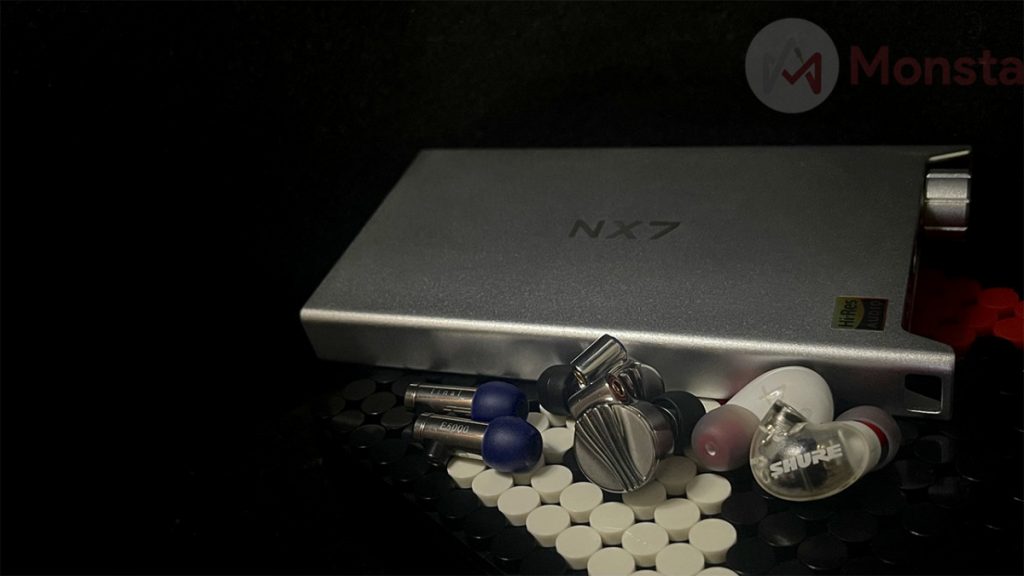
Synergy – Output
Final Audio E5000
Known as one of the “harder to drive” single-DD IEM, the Final E5000 is one of the gear that really benefits from the ample amount of power made readily available by the NX7. On high gain, yes high gain, it took the volume knob at right about 12 o’clock to make it sing gracefully. Once it gets there, long gone the overly bass-dominant signature and in comes a slightly more balanced yet still a very authoritative, clean lower end region. For those who doesn’t already know, the E5000 is a bass cannon. And quite a good one at that too. Sub-bass is slightly more pronounced and the bass became cleaner which renders better resolution and texture in this region. Complementing this attribute, the mids is now slightly brought forward (although still a bit overshadowed for the most part) without being too in your face nor affecting the upper-mids to sound thin. The once smooth and safe treble of the E5000 is now slightly more “alive” with enough details and nuances to keep you yearning for more. It’s subtle but a very noticable difference. For the Final E5000, it pairs best with the NX4 + NX7 stack which balances out all the frequency range to make it a delightful yet an arguably engaging listen.
FiiO FD5 (Large Bore Nozzle)
Time and time again, it helps by having readily available power when needed especially when coming across something like the Beryllium-plated DD FiiO FD5 or even the planar magnetic TinHifi P1. This Beryllium-plated DD proves that it needs quite a bit of juice to justify all the tech that was being put behind it. Now the FD5 is not as hard to drive as the E5000, coming in at around 10 o’clock on high gain to reach my comfortable SPL. With power, the bass is tighter, sometimes almost too tight which can be perceived as an early rolled-off. Along with that you’ll get cleaner lower region texture with enough punch to keep your feet tapping and your head banging. The mids remained clean and transparent with abundance of details, thanks to the Beryllium-plated driver. However the treble can be somewhat peaky and a little bit less ‘refined’. Again, this depends on your source and as some of you may already know, the FD5 (despite having a V/U-shape sound signature) favors warmer sounding DACs with some grunt outright power and it’s a wonderful partner for the Ifi Micro Black Label. Hence, I find it best to be paired with something similar = Micro Black Label + NX7.
Shure Aonic 4
How about the more efficient ones? Well I got you covered. The Aonic 4 being currently my most efficient IEM by having 7ohms impedance with 106dB SPL/MW sensitivity is not quite a source-friendly IEM. Granted that spec-wise it’s not even that sensitive plus it’s a hybrid but when used with a noticably noisy sources it can be an annoying experience with the Aonic 4. With the NX7 on medium gain (the max usable gain for this IEM), there are no hisses or electostatic noises that can be heard and for me that’s a win! Bass is clean, somewhat tight and the rumble is heard but not felt (being more akin to multi-BAs IEMs) when being fed with more power than it needed. Mids are slightly brought forward, bringing the upper mids more to life with slightly better perceived nuances and micro details. Treble remains safe, non-fatiguing and somewhat smooth. They’re quite a smooth sounding IEM in the upper registers anyway. I’ve found that the Aonic 4 synergises very well with the UD130 + NX7 combo (despite not needing such power output) which in my opinion the most balanced sounding pair.
Comparison
Ifi Micro iDSD Black Label (Amp only)
So, the Black Label is known for being a transportable powerhouse with loads of features. Now if we’re to compare the amplifier section, it’s worth noting that the Black Label does give out significantly more power output in comparison to the NX7 with the Turbo mode on the Black Label putting out 4W@16ohms load while the high gain on the NX7 is only rated at 1.4W@32ohms. That’s a huge difference. But power is not the only thing that matters here as more powerful amplifiers will suffer when being paired with more efficient gears. On that note, Ifi did a workaround to tackle this by implementing a selectable output settings (iEmatch & gain switch) to cater for wide ranges of IEMs/headphones out there. While the Black Label have all the fancy settings, the NX7 is much more simplified and easier to use. To me, it really comes down to use case scenario when comparing these two ‘portable’ beasts. As for the sound, both of them are not coloring the DAC in any significant way (with XBass & 3D+ switched off on the Black Label), none with the NX7. The killer feature for the Black Label is that its amplifier can alter the sound a bit by playing around with the Xbass and the 3D+ switch. The XBass will alter just the lower end region to give you the extra oomph while the 3D+ will provide a more open sense of space. But one thing I do notice instantly is that the Black Label’s amplifier is noticably more spread out giving you a sense of better separation and larger, more holographic soundstage (with the toggle switches turned off) while the NX7 is somewhat congested in comparison.
XuanZu XZ-U606 Pro (Muses 8920 Op-amp)
This relatively unknown brand actually produces a no-BS amplifier in my opinion, especially this U606 model. The one I’m comparing the NX7 to is the single-ended version. They also have this Plus variant in balanced (4.4mm) in/out. Despite being cheap (at 1/3 the price of the NX7) and almost half the size of the NX7, they’re quite a beast. However there’s no additional bass boost switch nor the ‘3D+’ switch here and not even a selectable gain switch on the U606 so it will continuously give an output of 700mW@32ohms. It may not seem that powerful at half the amount of power that the NX7 can provide but without the gain switch, it is significantly harder to be usable with efficient gears. So do consider this when you’re eyeing for a new amplifier. The one thing that made this U606 stands out is that it allow users the ability to swap its Op-amp (similar to Topping’s NX3s). What this means is that you can alter how the amplifier sounds (subtle changes) with different Op-amps. Granted that it may be an old-tech, not a Class-A, a hassle to be tweaked and etc. but for some people who’d like some DIY-ing and experiments, I’d say this is among one of the worthy amplifiers. Besides, these things will never be set and done just once and when it comes to audio chains it is more about synergy more than anything. With the Muses 8920 installed, the U606 is not that far behind when it comes to being transparent and clean. Yes, they can be transparent sounding, which is a desirable trait for an amplifier. Although not as clean as the NX7, it definitely is a wonder what a cheap amplifier could achieve with just a simple tweak (given that the users have the option to do so). They are however noticably behind when it comes to separation, they have a slightly congested soundstage and also having a slightly higher (audible) noise floor in comparison to the dead silent NX7, so there’s that.
For Who?
Realistically, I’m not sure why Topping launched the NX7 since it is an amplifier unit only instead of a DAC/AMP combo like the NX4 since most companies are releasing combos as a simpler solution. Yet the NX7 is the “almost” perfect portable amplifier to be released by Topping so far. They might as well be setting a new benchmark for this now very niche segment. Truth be told, recent DAC/AMP combos have been proven to be powerful enough to drive most IEMs/headphones with exception of the few very demanding ones. Even the dongles have been causing a phenomenal stirrups lately with such a small footprint. But it is understandable that one may not want to further deteriorate their source’s battery life with the dongles and then there are those who desire a cleaner, low-noise and uninterruptible audio chain a.k.a the Purists. Plus, the NX7 is made out of aluminium which feels premium and much better on hand as compared to the much simpler yet complex dongles.
Verdict
The NX7 really showcases how a very good amplifier should work, and it worked wonderfully. Their clean, unaltering nature is an exceptional example of how a good amplifier should be. Plus, an NFCA module in a portable package? It’s a steal to be honest. If only Topping retains the bass boost switch that can be found on the NX3s (if possible to be implemented similarly), the NX7 would be the best if not the perfect portable amplifier that one would ever need, period. Yes, maybe the bass switch is not compatible nor suitable to be implemented together with the NFCA module, but who knows that maybe one day it’ll become a reality because at the end of the day features will most likely take the spotlight on any product to differentiate one from another apart from justifying the asking price.
